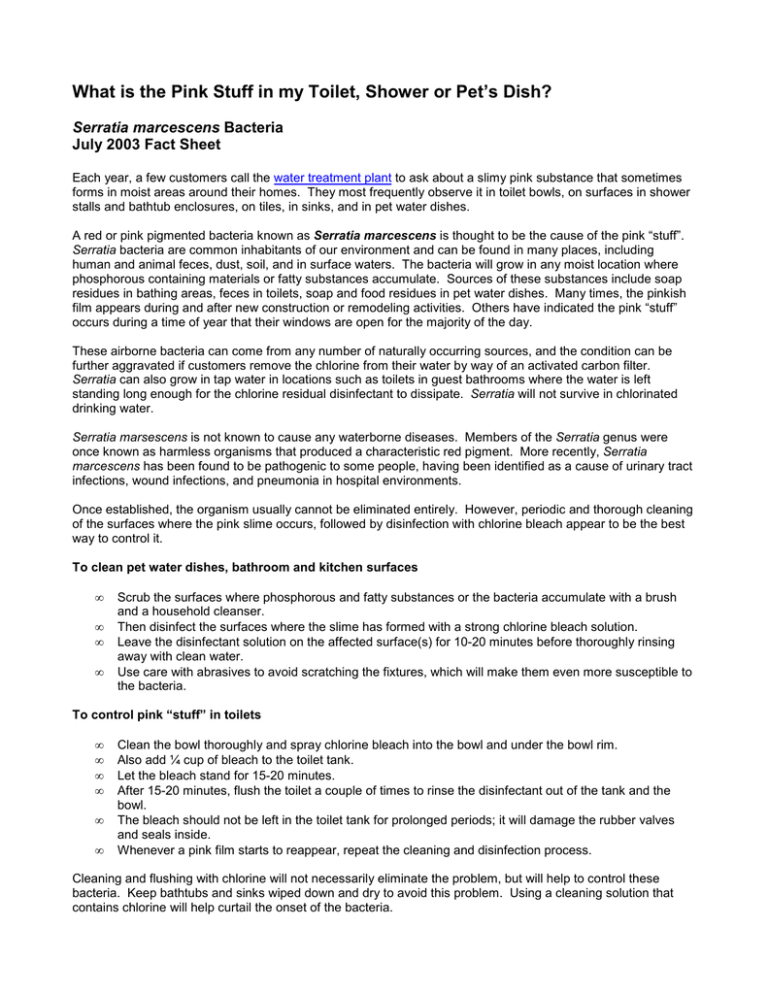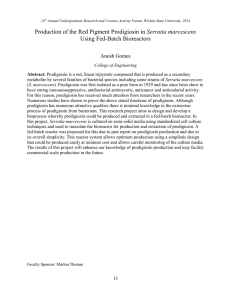What is the Pink Stuff in my Toilet, Shower or Pet`s Dish?
advertisement

What is the Pink Stuff in my Toilet, Shower or Pet’s Dish? Serratia marcescens Bacteria July 2003 Fact Sheet Each year, a few customers call the water treatment plant to ask about a slimy pink substance that sometimes forms in moist areas around their homes. They most frequently observe it in toilet bowls, on surfaces in shower stalls and bathtub enclosures, on tiles, in sinks, and in pet water dishes. A red or pink pigmented bacteria known as Serratia marcescens is thought to be the cause of the pink “stuff”. Serratia bacteria are common inhabitants of our environment and can be found in many places, including human and animal feces, dust, soil, and in surface waters. The bacteria will grow in any moist location where phosphorous containing materials or fatty substances accumulate. Sources of these substances include soap residues in bathing areas, feces in toilets, soap and food residues in pet water dishes. Many times, the pinkish film appears during and after new construction or remodeling activities. Others have indicated the pink “stuff” occurs during a time of year that their windows are open for the majority of the day. These airborne bacteria can come from any number of naturally occurring sources, and the condition can be further aggravated if customers remove the chlorine from their water by way of an activated carbon filter. Serratia can also grow in tap water in locations such as toilets in guest bathrooms where the water is left standing long enough for the chlorine residual disinfectant to dissipate. Serratia will not survive in chlorinated drinking water. Serratia marsescens is not known to cause any waterborne diseases. Members of the Serratia genus were once known as harmless organisms that produced a characteristic red pigment. More recently, Serratia marcescens has been found to be pathogenic to some people, having been identified as a cause of urinary tract infections, wound infections, and pneumonia in hospital environments. Once established, the organism usually cannot be eliminated entirely. However, periodic and thorough cleaning of the surfaces where the pink slime occurs, followed by disinfection with chlorine bleach appear to be the best way to control it. To clean pet water dishes, bathroom and kitchen surfaces • • • • Scrub the surfaces where phosphorous and fatty substances or the bacteria accumulate with a brush and a household cleanser. Then disinfect the surfaces where the slime has formed with a strong chlorine bleach solution. Leave the disinfectant solution on the affected surface(s) for 10-20 minutes before thoroughly rinsing away with clean water. Use care with abrasives to avoid scratching the fixtures, which will make them even more susceptible to the bacteria. To control pink “stuff” in toilets • • • • • • Clean the bowl thoroughly and spray chlorine bleach into the bowl and under the bowl rim. Also add ¼ cup of bleach to the toilet tank. Let the bleach stand for 15-20 minutes. After 15-20 minutes, flush the toilet a couple of times to rinse the disinfectant out of the tank and the bowl. The bleach should not be left in the toilet tank for prolonged periods; it will damage the rubber valves and seals inside. Whenever a pink film starts to reappear, repeat the cleaning and disinfection process. Cleaning and flushing with chlorine will not necessarily eliminate the problem, but will help to control these bacteria. Keep bathtubs and sinks wiped down and dry to avoid this problem. Using a cleaning solution that contains chlorine will help curtail the onset of the bacteria. Contact For further assistance, contact the Cary/Apex Water Treatment Facility Laboratory at (919) 362-5502. References American Water Works Association, Opflow Article: Question of the Month, page 3, November 2000. Water Quality Bulletin, Woodinville Water District, Woodinville


